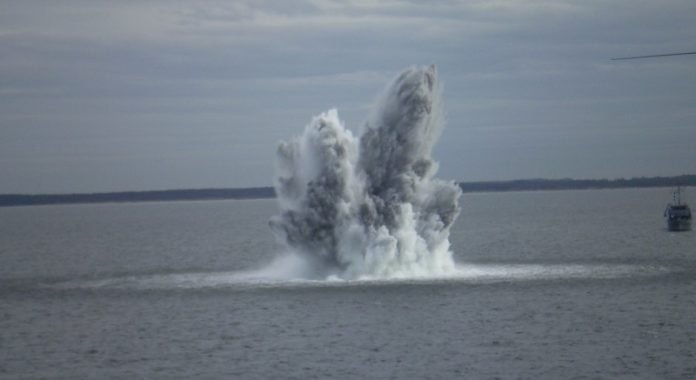
Decades after World War II, the ocean floor still hides a dangerous legacy: thousands of unexploded mines.
These relics not only pose a threat to ships but also risk contaminating the ocean.
Researchers have raised concerns about the environmental impact of controlled explosions used to clear these munitions, as recent findings reveal that the type of blast matters more than previously thought.
After World War II, it’s estimated that up to 385,000 metric tons of unexploded munitions were dumped into the Baltic Sea.
This includes a staggering 40,000 tons of chemical weapons. Over time, the metal shells of these mines can corrode, leaking toxic substances like TNT into the water.
To make the seas safer, technicians carry out controlled explosions to neutralize these underwater threats.
However, there’s a debate among experts about whether it’s better to use strong or weak blasts. Stronger explosions cause less environmental damage but create powerful shock waves, while weaker ones might leave behind more toxic residues.
A team led by Edmund Maser, in collaboration with the Royal Danish Navy, decided to study this issue closely.
They located World War II mines near Denmark and collected water and sediment samples from around them. Using mass spectrometry, they measured the levels of TNT in these samples.
As expected, areas around corroded mines showed higher levels of chemical contamination compared to intact ones. This finding was crucial, as it highlighted the risk of long-term environmental damage from these old munitions.
Next, the team set off controlled explosions near the mines, using both low and high-powered blasts. The results were alarming. Sediments near the site of the weaker explosions had up to 100 million times more TNT than before the blast. In contrast, the stronger explosions resulted in only a 250-fold increase in TNT levels.
Similarly, water samples taken after the weaker blast showed significantly higher TNT levels compared to those from the stronger explosion. This finding is concerning because the pollution from the weaker blasts could harm marine life, including microalgae, sea urchins, and fish.
Given these findings, the researchers suggest that less invasive methods should be considered for clearing these underwater relics. One such method could be using robots to carefully remove the explosive contents from abandoned mines.
This approach could prevent unexpected explosions and reduce contamination, safeguarding marine ecosystems.
The study’s results highlight a crucial aspect of ocean conservation: the need to carefully balance the risks and benefits of clearing historic munitions.
As we strive to make the oceans safer from the remnants of past conflicts, it’s important to consider the long-term environmental impacts of our cleanup efforts. This research could lead to safer, more effective methods to deal with these dangerous legacies lurking beneath the waves.



